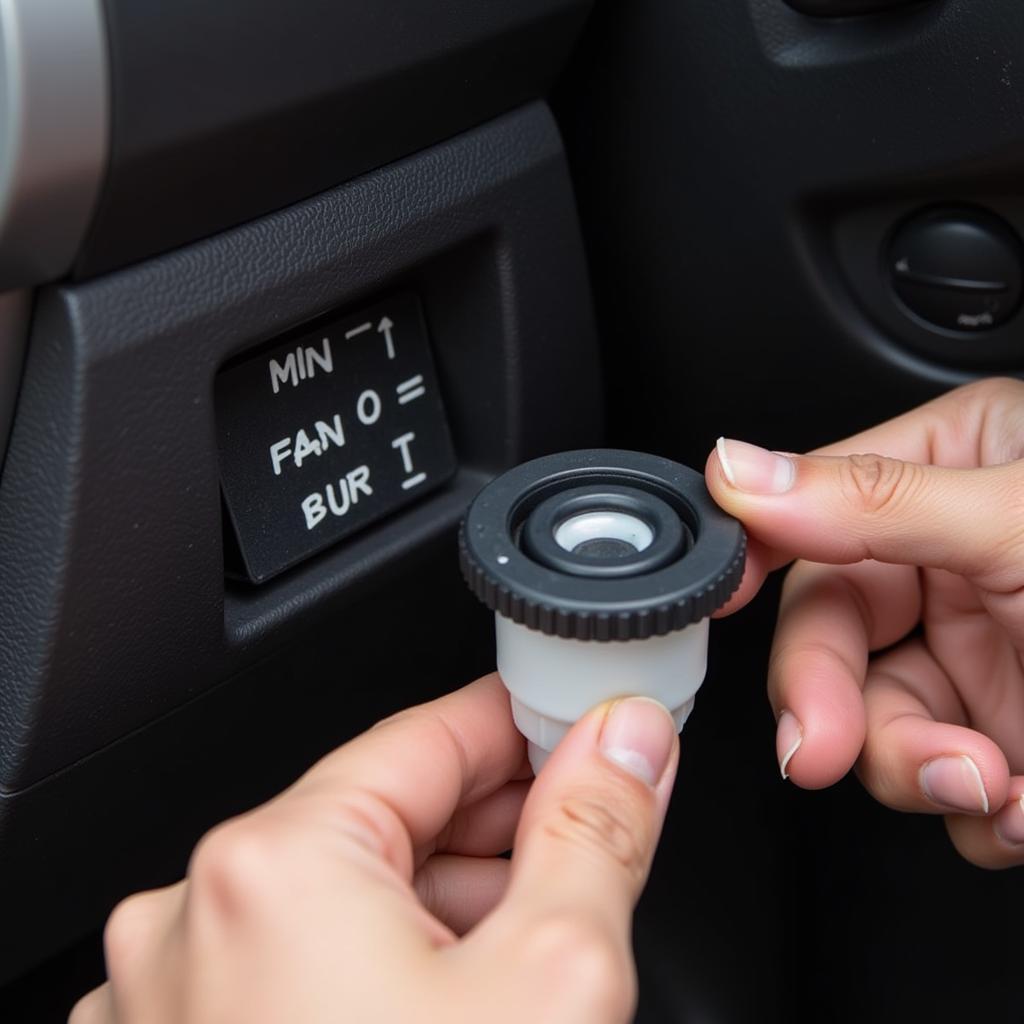The brake warning light on your Kia Picanto dashboard is a crucial safety feature designed to alert you to potential issues within the braking system. Ignoring this warning light could lead to reduced braking performance and increase the risk of an accident. This comprehensive guide will explore the common causes of the Kia Picanto brake warning light illuminating and provide you with practical solutions and insights.
Understanding Your Kia Picanto’s Brake System
Your Kia Picanto’s braking system is a sophisticated network of components working together to ensure safe and efficient stopping power. Key components include:
- Brake Pedal: The interface between you and the braking system, transmitting force to the master cylinder.
- Master Cylinder: A hydraulic pump that generates pressure when you press the brake pedal.
- Brake Lines: Metal tubes carrying brake fluid under pressure from the master cylinder to the brakes at each wheel.
- Brake Calipers: Housing the brake pads and pistons, the calipers clamp the brake pads against the rotors to slow or stop the vehicle.
- Brake Rotors/Drums: Metal discs or drums that rotate with the wheels. Friction is created when the brake pads press against them.
- Brake Fluid: A hydraulic fluid transferring force from the master cylinder to the brakes.
- Electronic Brake-force Distribution (EBD): This system optimizes braking force distribution between the front and rear wheels.
- Anti-lock Braking System (ABS): Prevents wheel lockup during hard braking, maintaining steering control.
Common Causes of a Kia Picanto Brake Warning Light
When the brake warning light illuminates on your Kia Picanto’s dashboard, it can indicate several potential problems:
1. Low Brake Fluid Level
Why it matters: Brake fluid is the lifeblood of your car’s braking system. A low fluid level often signifies a leak in the system, reducing braking efficiency.
How to check:
- Locate the brake fluid reservoir under the hood.
- Check the fluid level against the “MIN” and “MAX” markings on the reservoir.
Solution:
- If the fluid level is low, carefully top it off with the correct brake fluid type specified in your owner’s manual.
- Schedule an inspection with a qualified mechanic to identify and repair any leaks.
 Checking the Brake Fluid Level
Checking the Brake Fluid Level
2. Worn Brake Pads
Why it matters: Brake pads are designed to wear down over time. Excessively worn pads compromise braking performance and can damage the rotors.
How to check:
- Listen for screeching or grinding noises when applying the brakes.
- Inspect the brake pads through the wheel spokes for signs of excessive wear.
Solution:
- If the brake pads are worn beyond the recommended thickness, replace them immediately. It is advisable to replace all four pads simultaneously.
 Worn Brake Pads on a Kia Picanto
Worn Brake Pads on a Kia Picanto
3. Faulty Brake Light Switch
Why it matters: A malfunctioning brake light switch can prevent your brake lights from illuminating when you press the pedal, posing a significant safety hazard.
Symptoms:
- The brake warning light may illuminate.
- Your brake lights might not work.
Solution:
- Diagnosing and replacing a faulty brake light switch is best left to a qualified mechanic.
4. ABS System Malfunction
Why it matters: The ABS system is crucial for maintaining steering control during emergency braking situations.
Symptoms:
- The ABS warning light may illuminate alongside the brake warning light.
- You may experience unusual noises or sensations from the brake pedal during braking.
Solution:
- Diagnosing and repairing ABS issues require specialized equipment. Consult a qualified mechanic for diagnosis and repair.
5. Parking Brake Engaged
Why it matters: Accidentally driving with the parking brake engaged can cause significant damage to the braking system and reduce fuel efficiency.
How to check:
- Ensure the parking brake lever is fully released.
Solution:
- Release the parking brake if it’s engaged. If the light remains illuminated after disengaging the parking brake, consult a mechanic.
 Kia Picanto Dashboard Warning Lights
Kia Picanto Dashboard Warning Lights
What to Do When Your Kia Picanto Brake Warning Light Comes On
- Don’t Panic: Remain calm and assess the situation.
- Check for Obvious Issues: Ensure the parking brake is fully released.
- Find a Safe Location: Carefully pull over to the side of the road or a safe location.
- Check Brake Fluid: If it’s safe to do so, carefully check the brake fluid level.
- Seek Professional Help: If the brake warning light persists or you suspect a serious issue, do not attempt to drive further. Contact a qualified mechanic immediately.
Preventative Maintenance for Your Kia Picanto’s Brakes
- Regular Inspections: Schedule routine brake inspections with a qualified mechanic as recommended in your owner’s manual.
- Quality Brake Pads: Invest in high-quality brake pads designed for your Kia Picanto’s make and model.
- Brake Fluid Flushes: Follow the recommended brake fluid flush intervals outlined in your owner’s manual to maintain optimal brake fluid condition.
- Mindful Driving Habits: Avoid aggressive braking whenever possible. Smooth braking habits can extend the lifespan of your brake components.
Conclusion
Addressing brake warning lights promptly is crucial for your safety and the longevity of your Kia Picanto. By understanding the common causes and following the recommended solutions and preventative measures, you can contribute to a safer and more enjoyable driving experience.
Remember, if you’re ever unsure about the severity of a brake issue, err on the side of caution and seek professional assistance.
